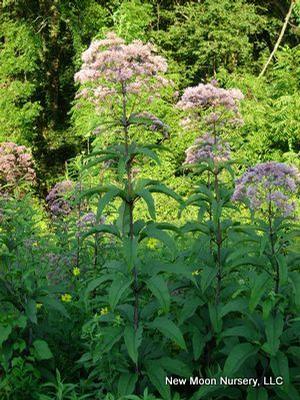Printed at http://www.newmoonnursery.com/index.cfm/

Joe pye weed is loved by butterflies and other pollinators. Good choice for conservation and restoration projects.
Eupatorium fistulosum
Joe pye weed
Native to North America
FIRST IMPRESSIONS: Eupatorium fistulosum is a striking tall boy that injects architectural interest to the late summer garden. This robust rhizomatous wildflower has sturdy stems with whorls of bold attractive foliage. In mid-summer, plants are topped with a frothy crown of rounded mauve-pink flower clusters. This species thrives in sunny moist sites where it is romanced by flocks of fluttering butterflies.
HABITAT & HARDINESS: Eupatorium fistulosum occurs in eastern North America from Quebec to Florida and west to Illinois, Missouri and east Texas.
Plants are indigenous to edges of moist open woods, creek banks, seeps, springs, moist meadows and low areas along roadsides and railroads.
Plants are hardy from USDA Zones 4-9.
PLANT DESCRIPTION: Eupatorium fistulosum is a bold upright perennial. Multiple stems emerge from the ground in spring looking somewhat like bamboo shoots at first.
By mid-summer plants have soared toward the sky and are almost shrubby. The sturdy stems are hollow and are clothed in whorls of large attractive leaves.
The leaves are arranged in groups of 4-7. They have toothed edges, an elliptical shape and are up to 9” long with stout purplish petioles.
From mid-summer until autumn, plants bear terminal dome shaped flower corymbs that range from 3-10” across. The flower clusters consist of many small feathery lavender-pink disk florets.
The blossoms mature into soft buff colored seed clusters.
Plants are 5-10’ tall with a spread of 2-3’ or wider.
CULTURAL & MAINTENANCE NEEDS: Eupatorium fistulosum prefers full to part sun and wet to moist soils. Plants tolerate clay, moist loam, seepy gravel or temporary standing water.
Avoid cutting stems back in winter to “tidy” the garden. If stalks remain, they will add winter interest, provide seed to birds and perhaps enhance cold hardiness. Accumulation of winter rain in the hollow severed stalks can cause the plant to decline.
This species is pest resistant and foliage is unpalatable to deer and other herbivores.
LANDSCAPE USES: Eupatorium fistulosum is a dramatic Accent for a Wildlife Garden or moist Meadow. Plants are also used as Butterfly Nectar Plants, Cut Flowers or as part of a Grouping or Mass Planting. This wildflower has Showy Blooms and provides Erosion Control. It can be used in Cottage Gardens, Deer Resistant Plantings, Rain Gardens, Water-wise Landscapes, Low Maintenance Plantings, Perennial Borders and on Roadsides.
COMPANION & UNDERSTUDY PLANTS: Try pairing Eupatorium fistulosum with Aster oblongifolius, Coreopsis tripteris, Lobelia siphilitica, Monarda fistulosa, Rudbeckia fulgida var. fulgida, Solidago rugosa or Sorghastrum nutans.
Eupatorium purpureum and Eupatorium maculatum are worthy substitutes as they are tall plants with similar flowers, whorled leaves and comparable cultural requirements.
TRIVIA: Unlike other members of the Aster Family, Eupatorium spp. flowers are composed only of disc florets with no rays.
Flowers attract skippers, moths and bees. The nectar is especially favored by butterflies and often two or more species can be observed foraging on a flower cluster. Swamp sparrows feed on the seed.
Taxonomists recently changed the name of this species to Eutrochium fistulosum. In general, the former Eupatorium spp. with whorled leave are now called Eutrochium spp. and the bonesets which have opposite leaves are still Eupatorium spp.
Height:
5-10 ftSpread:
2-3 ftSpacing:
3-6 ftUSDA Hardiness Zone:
4-9Bloom Color:
MauveEupatorium fistulosum Characteristics
Attracts Wildlife
- Butterflies
- Pollinators
Attributes
- East-Coast Native
- Drought Tolerant
- Rain Garden
- Dried Flower
- Cut Flower
- Clay Soil
- Naturalizing
- Long Blooming
Exposure
- Full Sun to Partial Shade
Flowering Months
- August
- July
Foliage Color
- Green
Growth Rate
- Fast
Juglans nigra Tolerance (Black Walnut)
- Yes
Season of Interest (Foliage)
- Summer
- Spring
Soil Moisture Preference
- Wet to Moist
Interesting Notes:
For more information on this plant, visit the USDA PLANTS Database: http://plants.usda.gov/java/profile?symbol=EUFI14
